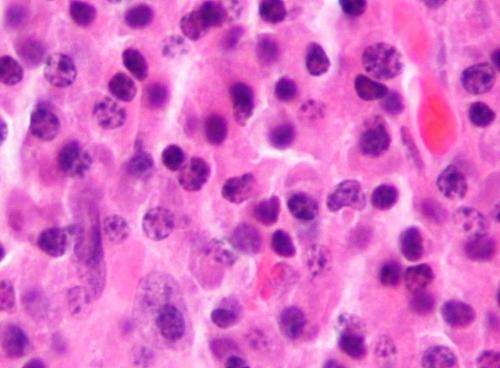This article has been reviewed according to Science X's editorial process and policies. Editors have highlighted the following attributes while ensuring the content's credibility:
fact-checked
peer-reviewed publication
trusted source
proofread
Recent FDA committee vote could speed multiple myeloma drug approval

A U.S. Food and Drug Administration committee voted unanimously in April to approve a new clinical endpoint, minimal residual disease (MRD), when evaluating proposed drugs to treat multiple myeloma.
The 12–0 vote by committee members was based primarily on an analysis spearheaded by C. Ola Landgren, M.D., Ph.D., director of the Myeloma Research Institute at Sylvester Comprehensive Cancer Center at the University of Miami Miller School of Medicine and the paper's first author.
This Landgren-led study, published May 20 in the journal Blood, featured a meta-analysis of a dozen phase 2 or 3 clinical trials that proved enlightening. "It shows that there is a very tight correlation between MRD and clinical outcomes both in newly diagnosed and relapsed patients," he explained.
Urgent need
Multiple myeloma, a cancer of the plasma cells in bone marrow, is the second most common leukemia type. Despite recent therapeutic advances, 40% of multiple myeloma patients die within five years.
Consequently, new drug therapies are urgently needed to improve overall patient outcomes.
If the FDA adopts the committee's recommendations—which it typically does—the results will be "amazing" for patients, Landgren said. This new endpoint will enable drug approval through a special, accelerated pathway based on MRD and shave years off the process, he added.
Landgren believes the potential impact cannot be overstated. "It will be like switching from steam engines to jet planes," he said.
While the FDA adoption decision may occur within weeks, its final, full approval would depend on evaluation of longer-term clinical outcomes, including overall survival.
Pathway for other cancers
Landgren and collaborators noted that this analysis also shows a path forward for other blood cancers and solid tumors. Since the FDA committee vote in April, Landgren has fielded calls from experts in other cancer specialties, asking for advice on adopting MRD as an FDA-sanctioned endpoint.
They will need to collect the data to convince the FDA, Landgren said, but hopefully it will not take 15 years. That's how long he and his colleagues have been investigating MRD use as a biomarker for treatment success.
The long road
The current study is called the EVIDENCE meta-analysis and its origins began at the National Cancer Institute, part of the National Institutes of Health, where Landgren was an investigator in 2009.
"With the drugs we had at the NIH, we could achieve very deep responses in a very high percentage of patients," he said. "I was thinking if this continues, we will eventually have deep responses in the majority of patients and it's going to be difficult to develop new drugs."
That's because it's hard to show an improvement over existing drugs that already yield a response. One key endpoint—overall response rate—only requires half of the tumor to shrink.
"We were getting close to 99% of our patients having that response," Landgren explained. "It was getting very hard to develop a drug to show superiority."
Landgren recalled performing calculations in his NCI office suggesting it would take 10 years for mature data on a large clinical trial—and that was on top of the two years it usually takes to enroll and begin treating patients. That's when he and his colleagues went all-in on MRD as an endpoint.
He started talking to the FDA about the necessary data—and began collecting it. That took a "major effort" in part because he had to convince multiple drug companies to share their data. Meanwhile, technology to measure residual tumor cells also improved.
The minimum sensitivity for MRD-negativity is typically one myeloma cell per 100,000 normal cells. A newer, DNA-based test cleared by the FDA can detect one in a million cells.
The EVIDENCE
The EVIDENCE meta-analysis evaluated MRD data in both newly diagnosed and relapsed/refractory patients, including those whose tumors returned or did not respond to treatment.
The study evaluated eight clinical trials of newly diagnosed patients, covering almost 5,000 patients in total. It showed a "strong association" between MRD negativity and progression-free survival, a commonly used clinical outcome. The association between negativity and overall survival among participants was "moderate."
Four clinical trials involving relapsed/refractory patients were also evaluated in the analysis, which showed a "strong association" between MRD and both progression-free and overall survival among these patients.
Landgren estimates that a new MRD endpoint could mean that FDA-ready data from clinical trials could emerge within three years after the start of clinical trial enrollment.
"We don't yet have a cure for this disease," he said, "so we need a much faster timeline for new therapies."
More information: Ola Landgren et al, EVIDENCE meta-analysis: evaluating minimal residual disease as an intermediate clinical endpoint for multiple myeloma, Blood Journal (2024). DOI: 10.1182/blood.2024024371


















